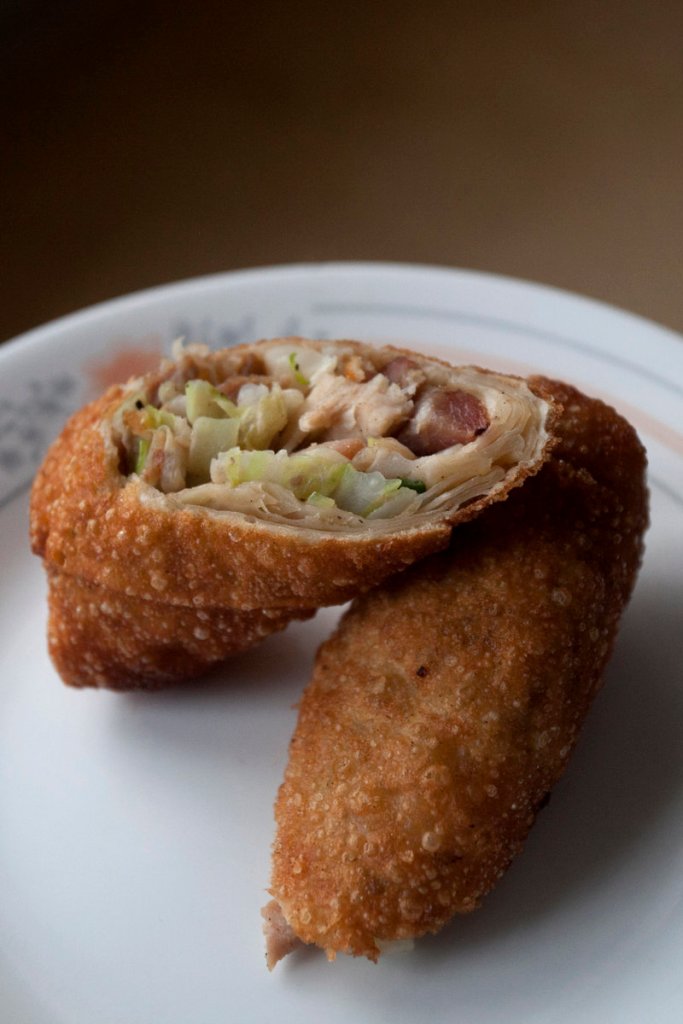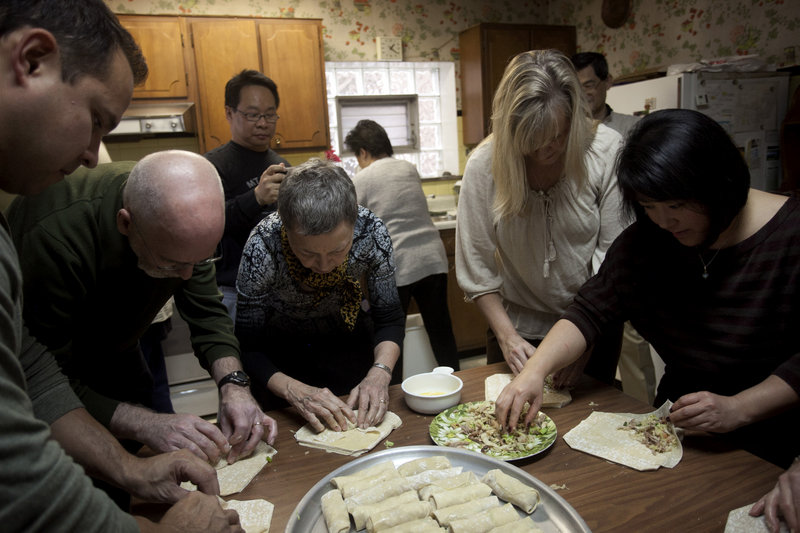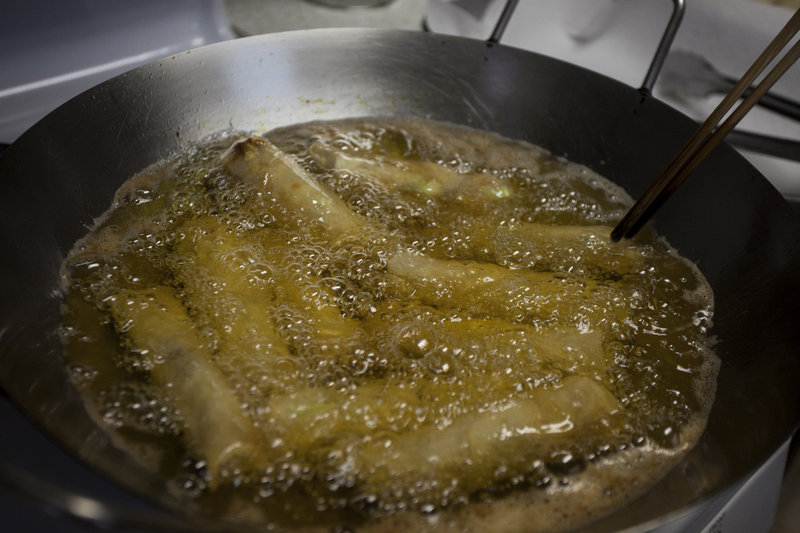CHICAGO — Born and bred in southern China, Fanny Go did not grow up eating egg rolls.
Family meals in her part of Guangdong province were dominated by rice, greens, preserved vegetables and morsels of meat.
But ever since she and her late husband Tom decided to whip up a batch for a Rogers Park Chicago block party 45 years ago, these chubby, stubbly, golden cylinders have become a family tradition.
“My parents would make as many as 500 for people at the block party to eat and take home,” says the Gos’ eldest daughter, Jean. “They knew that food always brought people together. So, over the years, they created a lot of good relationships around here.”
Like Fanny Go, who came to the U.S. in the early ’60s, the egg roll represents a 20th-century meeting of two cultures. Though dim sum chefs in Hong Kong produce a similar snack called a spring roll, the egg roll, as we know it, is a creation of early Chinese-American restaurateurs who used local ingredients to create Chinese-ish foods that would appeal to American diners.
One of the restaurateurs who helped popularize the egg roll was my grandfather, Harry Eng, whose nephew, Tom Go, worked as a manager in the family’s downtown Chicago chop suey palaces (among them Hoe Sai Gai and South Pacific) for decades. Tom Go based his egg roll recipe on the appetizers that proved such a hit with the restaurants’ clientele.
Today Fanny Go, 87, carries on the Chinese-American tradition by making the savory treats for parties and family gatherings. She recently shared her recipe — which can take up to three days — with a convivial group who gathered at Go’s home to learn, cook and eat. One of the biggest surprises was that most of the ingredients can be found in the average American grocery store, if not in your kitchen.
I joined in to learn more about this side of my family and to bring home some tangible (not to mention delicious) link to the Eng family’s restaurant past. My great-grandfather, grandfather, great-uncle, aunts and uncles opened nearly a dozen of these establishments starting in the 1930s, with the last — The House of Eng in Hyde Park — closing in the ’80s.
Go started the project a few days earlier by marinating 10 pounds of pork shoulder in a store-bought char siu sauce (hoisin and five spice-based barbecue sauce) and then roasting the meat on wire racks in the oven. Early guests were put to work julienning the pork into thin strips. Others sliced green cabbage into ribbons, blanched them and then squeezed them dry in sheets of cheesecloth.
My father, who worked summers in the family restaurants, remembers cooks using whole tablecloths to squeeze the mountains of blanched cabbage needed for the daily egg rolls.
“Many restaurants,” Go explains through a translator, “used only cabbage for the filling because they wanted to keep costs down.” But Fanny and Tom Go added plenty of rich barbecued pork, shredded chicken, chunks of boiled shrimp, chopped green onions and other touches to their version.
“You can add mushrooms, bamboo shoots or whatever you want,” she says.
After Go assembles the main elements (cabbage, pork, shrimp and chicken) into a huge basin, she sprinkles in a variety of unexotic spices: salt, pepper, sugar, chicken bouillon powder and cinnamon.
Next comes her secret ingredient: a jar of creamy peanut butter, heated in a pan with some vegetable oil until it was liquid enough to be poured into the mixture. Finally, Go showers the filling with chopped green onion and kneaded the whole thing thoroughly with her sturdy hands.
When it comes time to roll, Go places a tall stack of perfectly square egg roll wrappers on the cutting board and lops off the corners for easier assembly. She demonstrates a perfect roll by squeezing a handful of filling in her fist, plopping it on the bottom corner of the wrapper and tightly rolling it into a chubby cylinder, the final flap sealed with a swipe of egg wash.
Guests set to work rolling dozens more — with decidedly mixed results — as Go heats several cups of vegetable oil in her shiny wok.
Despite her advanced years, the octogenarian insists on doing much of the hard work herself, mixing the mound of filling, carrying the pots and boxes, and standing at the stove to fry every single one of the 100 egg rolls we assembled.
“Someone else might make a mess of my stove and wok,” she says when her son, Rich, suggests she sit and take a rest.
When the first stubbly cylinders emerge from the wok, hot crisp and deeply golden, every guest wonders the same thing: When can I try one?
Finally, after about a dozen are stacked in a paper towel-lined pan, Go gives the OK. I slice one open, releasing a puff of cabbagey, porky steam. I dip it in the brightly colored store-bought duck and mustard sauces. I take my first crunchy, sweet, spicy, savory bite. And I am transported right back to the opening crunch of dozens of Eng family restaurant meals from my youth.
As someone who, for decades, wrote about “real” ethnic food in Chicago, I admit to snobbishly shunning the cuisine upon which my ancestors built their fortune. But if someone who spent the first third of her life in China can embrace it, so can I.
Indeed, when my brother and I made a huge batch of Go’s egg rolls for our Chinese-Puerto Rican Christmas celebration in December, they were an enormous hit with the Chinese and non-Chinese relatives alike. They even inspired my Chinese-Jewish cousin to share his parents’ (former restaurant owners) old Crab Rangoon recipe with me.
These recipes may not be ancient Chinese secrets, but they do reflect popular products of Chinese ingenuity.
According to author Andrew Coe, who wrote “Chop Suey: A Cultural History of Chinese Food in the United States,” the egg roll was likely invented in New York sometime in the early 1930s. One of the chefs who claimed the honor, Henry Low, even included an egg roll recipe in his 1938 book “Cook at Home in Chinese.” According to Coe, the recipe included “bamboo shoots, roast pork, shrimp, scallions, water chestnuts, salt, MSG, sugar and pepper,” a much more luxurious mix than the “cabbage, flecked with bits of pork and carrot for color,” that “rose to dominate the restaurant tables and freezer sections.”
With the Gos’ recipe, many of those luxurious fillings have been restored — and Fanny Go encourages home cooks to add just about anything they want as long as it’s chopped small, fully cooked and drained of most moisture.
During Lunar New Year celebrations — which began Sunday — it’s customary, in China, to serve visiting family and friends delicate spring rolls to welcome the next season. But if you live someplace where February doesn’t feel much like spring, a plump, sturdy American egg roll could be just as welcome. And now that the Cantonese-American egg roll has — like Go — thrived through more than eight decades, it’s probably safe to say that it has earned a place as a tradition of its own.
EXTRAS
1 tablespoon sesame oil
½ cup boiled shrimp chopped into dime-size pieces
½ cup soaked, squeezed and thinly sliced shiitake mushrooms
½ cup julienned and well-drained bamboo shoots
¼ cup thinly sliced water chestnuts
½ cup bean sprouts
EGG ROLLS
Prep: 1 hour, 30 minutes
Cook: 2 minutes per batch
Makes: 12 to 16 egg rolls
This recipe is adapted from the one Fanny Go has made for decades. The amounts have been reduced from her recipe, which serves a crowd. Look for barbecued pork in Chinese barbecue stores, or you can make it by marinating approximately 2-inch-wide sections of pork shoulder/butt in store-bought char sui sauce overnight and then roasting in a 350 degree oven on a rack over a pan lined with foil until done. Go suggests several extra ingredients that can be stirred into the filling; see the list and suggested amounts below. (The number of egg rolls made will depend on how much filling used per piece and any extra ingredients.)
½ cup smooth peanut butter
1 tablespoon peanut or vegetable oil
2 cups julienned Chinese barbecued pork
10 cups shredded green cabbage (about 1 large cabbage), blanched, squeezed dry in a dish towel
½ cup chopped green onions
2 teaspoons sugar
2 teaspoons salt
½ teaspoon freshly ground pepper
¼ teaspoon cinnamon
Extras, see list above
12 to 16 large (7-by-7-inch) egg roll wrappers
1 egg, beaten in a small bowl
Vegetable oil, peanut oil or lard for frying
For the filling, heat the peanut butter in a small saucepan over low heat until pourable, adding 1 tablespoon peanut oil if needed to get the proper consistency. Allow to cool slightly. Combine the pork, cabbage, onions, sugar, salt, pepper, cinnamon and any of the optional extra ingredients in a very large bowl until thoroughly blended. Hands work best to do this. Pour cooled, but still liquid, peanut butter into the mixture; mix thoroughly.
Cut off 1 inch from each of the corners of the wrappers for easier rolling. Place stack in front of you with one corner pointing toward you. Place a handful (about ¼ cup) of filling near the bottom corner; roll corner over the filling, tightly rolling up to just over half way. Fold in side corners snugly; continue rolling until there are 2 inches of wrapper left. Brush some egg wash over the final corner; continue rolling over it to seal the egg roll.
When all egg rolls are rolled, heat oil or lard in a heavy pan or wok until it reaches 350 degrees. Fry egg rolls, in batches, until golden brown; drain in a paper towel-lined pan.
Eat while hot, dipped in duck sauce, sweet and sour sauce and/or hot mustard.
Per egg roll (for 16): 277 calories, 10 g fat, 2 g saturated fat, 25 mg cholesterol, 34 g carbohydrates, 12 g protein, 841 mg sodium, 2 g fiber.
Send questions/comments to the editors.





Success. Please wait for the page to reload. If the page does not reload within 5 seconds, please refresh the page.
Enter your email and password to access comments.
Hi, to comment on stories you must . This profile is in addition to your subscription and website login.
Already have a commenting profile? .
Invalid username/password.
Please check your email to confirm and complete your registration.
Only subscribers are eligible to post comments. Please subscribe or login first for digital access. Here’s why.
Use the form below to reset your password. When you've submitted your account email, we will send an email with a reset code.